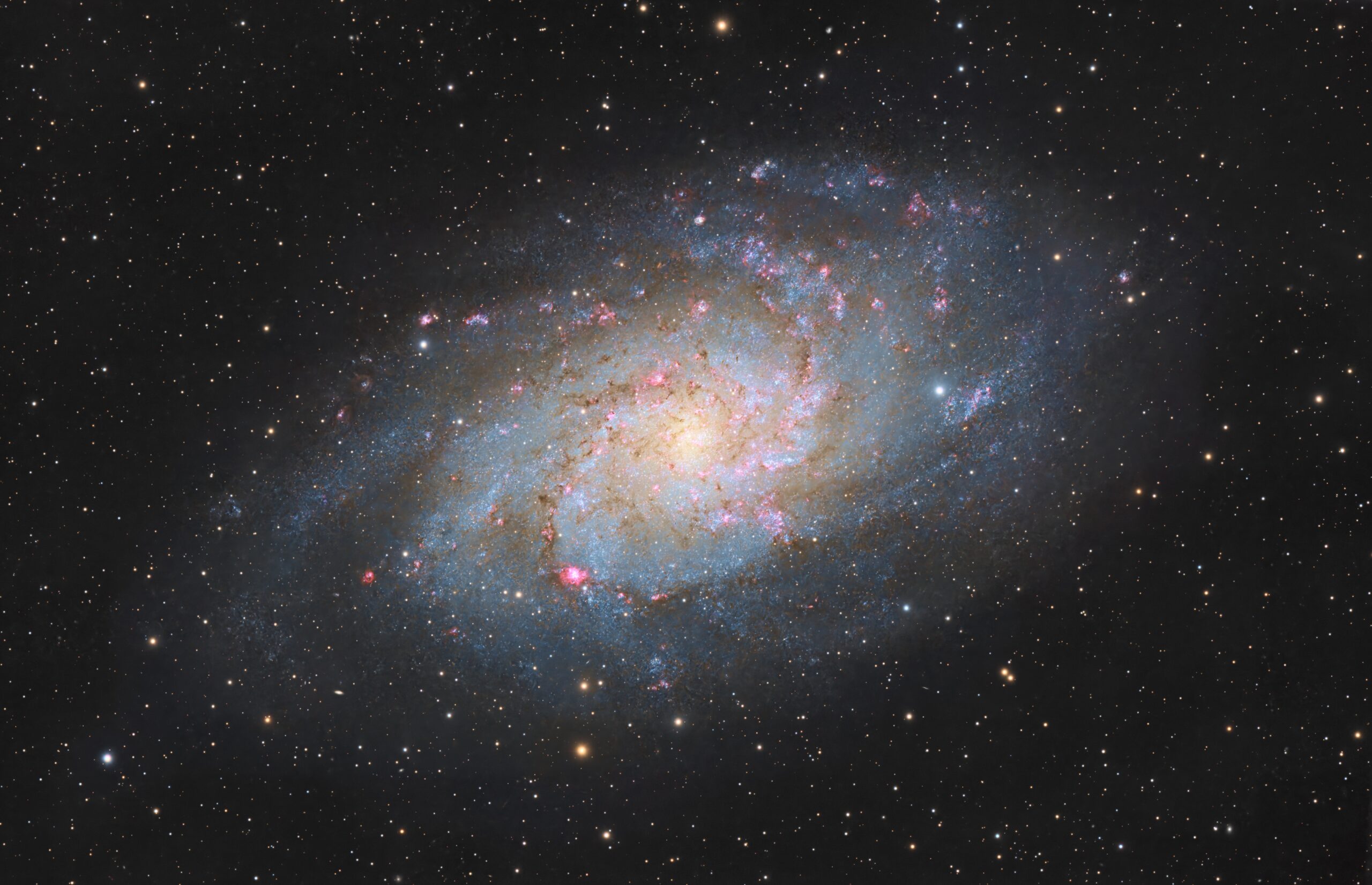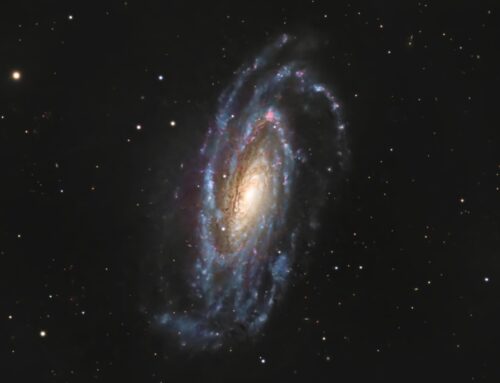M33, Triangulum Galaxy
 Click image for full size version
Click image for full size version
October 25, 2025
M33, familiarly known as the Triangulum Galaxy, is one of the closest large galaxies to Earth. It’s located in the constellation Triangulum at a distance of about 2.5 million light years and has a diameter of around 60,000 light years. It lies not far in the sky from another big, beautiful galaxy: M31. M33 is visible to the naked eye in a dark sky, and is a fine sight in a large telescope. I image it with every setup that I try.
Because of its size and relative closeness to us, M33 displays a wealth of detail in photographs, including a variety of colours in different structures: blue star clusters, pink emission nebulae (similar to our Milky Way’s Orion Nebula), brown dust lanes and a yellowish core. Numerous other galaxies are also in the image, but can easily go unnoticed due to the overwhelming richness of M33.
Tekkies:
Acquisition, focusing, and control of Sky-Watcher Wave 150i mount and other equipment with N.I.N.A. and Green Swamp Server. Guided with PHD2 using a Sky-Watcher 50mm EDX guide scope and QHY5 II L guide camera. Focus/rotation with Primalucelab 3″ ESATTO/ARCO. Equipment control with Primalucelab Eagle 6 Pro computer. All pre-processing and processing in PixInsight. Acquired from my SkyShed in Guelph under average transparency and seeing and little to no moonlight from August 18 to October 20, 2025.
Sky-Watcher Esprit 120 refractor, QHY168C Pro camera, Optolong filters
L-Quad Enhance Filter: 233 x 5m = 19hr 25m
L-eXtreme Filter: 51 x 5m = 4hr 15m
Total: 23hr 40m
Preprocessing: The WeightedBatchPreProcessing script was used to perform calibration, cosmetic correction, weighting, registration, integration and Drizzle integration of all frames (2x drizzle, 0.9 Drop Shrink).
RGB and NB masters: The L-Quad Enhance Filter master was renamed ‘RGB’ and used as the broadband base image. The red channel was extracted from the L-eXtreme Filter master and renamed ‘Ha.’
Gradient Removal: DynamicBackgroundExtraction was applied to the RGB and Ha masters.
Colour Calibration: BlurXterminator was applied to the RGB master with Correct Only selected, followed by ColorCalibration.
Deconvolution: BlurXterminator was applied to the RGB and Ha masters with Automatic psf , star sharpening set to 0.5, and non-stellar set to 0.9.
Linear Noise Reduction: NoiseXterminator was applied to the RGB and Ha masters with settings Amount=0.9 and Interations=4.
Ha Continuum Subtraction: The SpectrophotometricContinuumSubtraction script by Charles Hagan was used to remove continuum emissions and stars from the Ha master using the red channel of the RGB master as the continuum reference image.
Stretching: HistogramTransformation was applied to make a pleasing image from the RGB and Ha masters. Approximate background level after stretch was 0.1 for the RGB master and 0.08 for the Ha master.
Nonlinear Processing
Star Removal and processing: StarXterminator was used to remove the stars from the RGB master with Unscreen checked. Colour was increased in the RGB stars-only image by applying Curves saturation through a star mask.
Initial Saturation Boost: CurvesTransformation’s saturation tool was used to boost colour in the galaxy in the starless RGB image. A range mask made with RangeSelection was used to protect the background.
H-alpha Blending: The contiuum-subtracted Ha was added to the RGB image using Jurgen Terpe’s CombineHaWithRGB script.
Nonlinear Noise Reduction: NoiseXterminator was applied to the HaRGB image with settings Amount=0.9 and Iterations=5.
Contrast Enhancement: Jurgen Terpe’s MakeHDRImage was used to slightly compress the core of the galaxy. LocalHistogramEqualization was then applied twice. A Contrast Limit of 1.5 and 1 iteration was used for each application (scale 150, strength 0.35, and scale 40, strength 0.25).
Sharpening: MultiscaleMedianTransform was used to sharpen Layers 1 – 5 with strengths of 0.02, 0.02, 0.01, and 0.01, respectively.
Star Restoration: Stars were added back into the image using the PixelMath expression combine(starless, stars_only, op_screen())
Final Steps: Background, galaxy, and star brightness, contrast, and saturation were adjusted in several iterations using CurvesTransformation and Jurgen Terpe’s SelectiveColorCorrection script with masks as required. The masters were down-sampled x2, to their original resolution, for sharing in this post. Full resolution available on request. ICCProfileTransformation (sRGB IEC61966-2.1; Relative Colorimetric with black point compensation) was applied prior to saving as a jpg. The finder chart was made using the FindingChart process.







You do things with camera and telescope that I can’t do with my imagination! THANKS FOR SHARING!